In 2001 Dr. Vergara was conferred the title National Scientist for his achievements in rice physiology, and promoting rice science and technology. It was the highlight of a long and consistently productive career. A humble man, he “was on cloud nine,” he said, after being nominated as a National Scientist by the National Academy of Science and Technology agriculture division.
Dr. Benito Vergara is popular for yet another reason. While his contributions to rice science as a research scientist at the International Rice Research Institute (IRRI) are important, his legacy lies in communicating science to non-scientists. Among hundreds of publications in scientific journals is his most popular work, A Farmer’s Primer on Growing Rice, an illustrated manual that is one of the world’s most widely published agricultural texts (Hargrove, 2001). The official version of the Primer has been translated into more than 45 languages, with more than 50 separate translations including Waray, Farsi, Kiswahili, Malagasi, Bengali, Khmer and others. His passion in promoting science to the public continued even in his retirement years, when he helped build museums and published photo catalogs of ornamental plant varieties.
In 2001 Dr. Vergara was conferred the title National Scientist for his achievements in rice physiology, and promoting rice science and technology. It was the highlight of a long and consistently productive career. A humble man, he “was on cloud nine,” he said, after being nominated as a National Scientist by the National Academy of Science and Technology agriculture division.
His surprise would be puzzling to anybody reviewing his life in science, with over 500 publications, a series of high-level international positions, and a productive life in the science community after retirement. The real surprise for many was why he had not been awarded sooner. Despite having one of the largest laurels on which to rest, Dr. Vergara refuses to stop, and he continues to pursue plans for raising the profile of science in the country.
A child and a camera
The seventh child of a seventh child, Dr. Vergara was born to Jose Vergara, a medical doctor, and Luisa Sibug Vergara, a nurse. Jose Vergara started an orphanage after World War II in Mandaluyong called Welfareville, where Dr. Vergara and the rest of his siblings grew up. Dr. Vergara’s father owned a commercial photography studio and as a result, most of the family had a familiarity with cameras, film developing, and photography.
As a teenager he was fascinated with photographs. His father brought him along to trips between his classes at the UP Integrated School in Diliman. Everywhere they went, the young Dr. Vergara took photos of people, places, and of course, plants. Today he continues to stop and take photos of plants, even on holiday trips with his grandchildren. This resulted in a series of books cataloging different varieties of ornamental plants. Botanists describing plants accompany descriptions with illustrations to depict the shape of leaves, flowers, and stems. His constant drive to take photos is inspired by a belief that words and illustrations are inherently incomplete, that they can never accurately capture what the eye can see.

Dr. Benito Vergara dancing Pandango sa Ilaw. (Photo: philscitech.org)
Not an ordinary childhood
As one of the youngest siblings, Dr. Vergara was raised mostly by his older sisters Betty, Lucy and Belen, who taught him how to cook, do household chores and instilled in him a so-called “Vergara” brand of diligence and perseverance. But it was his youngest sister Cecilia with whom Dr. Vergara learned how to dance, a skill that would prove significant and formative in his early teenage years.
When Dr. Vergara was in grade school, World War II had reached the Philippines, directly changing his life. Dr. Vergara and Cecilia were then part of a child dance troupe entertaining American military servicemen with cultural dances like tinikling and pandanggo sa ilaw. He continued dancing throughout adulthood, performing in cultural shows in the United States when in graduate school and during his years at IRRI.
A career as a botanist and rice physiologist
Dr. Vergara says that his career in rice was not something he pursued but one that he followed as opportunities arose. His father tried to convince him while in college to follow in his footsteps and become a medical doctor. Dr. Vergara was not all that interested in medicine, but he chose Botany as his college major in UP Diliman as a pre-medicine course. Biology classes further galvanized his fascination with plants, and he started exploring the possibility of working in botany instead of medicine. In his senior year, his best friend was accepted into a Master’s Degree program at the University of Hawaii. At the last minute, his friend backed out of the program, choosing instead to become a Jesuit priest. UP had to rush to find a replacement, and Dr. Vergara was eventually recommended.
This was a turning point in his life, Dr. Vergara recounts, because if his friend had not withdrawn then he would have become a doctor instead of a scientist. He went to Hawaii alone, with one suitcase, very little money, and not a single soul to meet him. Arriving at the local YMCA, he found out they were closed for a holiday, so he holed up in their lobby for the night. The next day he went in search of his adviser. Dr. Vergara completed his Master’s degree in less than two years and entered a PhD program in Plant Sciences at the University of Chicago, which he completed in 1960. He was only 26 years old.
Upon his return to the Philippines, he intended to join the UP faculty, but IRRI Director Dr. Robert Chandler asked him and Dr. Ben Juliano (who would also be recognized as a National Scientist) to help start the IRRI laboratory where they would catalogue, screen, and eventually breed different varieties of rice. Ben Vergara joined IRRI as an Associate Plant Physiologist in 1961.
He recalls the excitement of his first few years at IRRI. There was no research program, no gene bank, no screening protocols, no scientists: just one building. He and Dr. Juliano were given a blank check to order laboratory equipment and supplies. They built the laboratory from scratch and were later joined by four other scientists to set the research agenda for the plant physiology work at the institute. Since then, he has served IRRI in many different capacities. As a scientist he became the head of the Plant Physiology Department and head of the Agronomy, Plant Physiology, and Agroecology Department until 1991. In 1992, he was appointed Director for Administration until he retired in 1996.
His work in IRRI focused on three major research areas: the flowering response of rice to photoperiodism, rice physiology, and deep water rice. He started with the photoperiod response of the rice plant, or its response to the length of the days (the amount of sunlight) when rice is farmed. At that time there was little data and few published studies. The goal was to help develop varieties that could be planted any time of year, and harvested at a predictable number of days after planting. This way rice did not have to be confined to one harvest per year. If a fixed growth duration could be determined, then scientists can predict harvest time. Through his work, IRRI identified the optimum growth duration of rice: between 120 and 130 days, regardless of variety. His research led to discoveries that allowed farmers to plant rice two to three times per year.
After his work on photoperiodism he turned to the problem of flooding. He studied the physiology of deep-water and flood-tolerant rice plants. When a non- deep-water rice plant is submerged in water for extended periods — for instance, 10 days — the parts that are below water will rot and eventually kill the plant. Farmers whose rice fields are hit by typhoons and heavy rainfall are extremely vulnerable when rice fields are flooded.
Together with students from Thailand, Indonesia, India, and Bangladesh, Dr. Vergara looked for different varieties of flood-tolerant rice. They identified FR13a, a variety in India that would grow through several feet of water and then flower on top after a flood had receded. Dr. Vergara and his team started screening their germplasm collection to isolate the traits that would identify flood tolerance. While some varieties had promise, it was still FR13a that proved most resistant.
Based on this information, breeders at IRRI began selecting varieties to cross with FR13a. But FR13a’s remarkable flood-tolerance came with a price: it was a low-yield variety. Throughout this process, Dr. Vergara developed the standard screening procedure for flood tolerance, allowing IRRI to further screen thousands of genetic lines. Today, screening for flood tolerance continues, and scientists are still crossing breeds and using newer techniques based on the procedures Dr. Vergara designed. His research directly led to the development of procedures to improve the flood tolerance of rice, which are practiced through official national breeding programs in the Philippines and many other rice-growing countries.
Dr. Vergara’s research program was instrumental to the development of two types of high-yielding types of rice plants. He has worked on tolerance of rice plants to low temperatures, identifying the Fujisaka5 variety as the ideal control, and developing protocols for using it as a basis for the screening of thousands of lines in South Korea to find the best yielding cold-tolerant varieties. His work included research on how the rice grain fills up and the factors that affect it, leading to the development of rice varieties with fatter and fuller grains.
Despite all his own research, Dr. Vergara is most proud of the students that he worked with at IRRI. His student Dr. Tawee Kupkanchanakul from Thailand was later named National Scientist of Thailand, advising Thai scientists and even the Queen of Thailand. Ben Vergara worked with students from Indonesia who went on to do intensive work in developing flood-tolerant rice, heading their own experiment stations. His postdoctoral and graduate students now lead experiment stations in Nepal, Ecuador, and China.
The Farmer’s Primer
In his travels to rice-growing countries, Ben Vergara observed farmers and extension workers grappling with complex technical and scientific information about growing rice. The concepts were not difficult per se, but the materials and language used to explain them were, to him, dense and impenetrable. Back at IRRI, as he observed the training of agricultural extension workers and listened to experts deliver a lecture about photosynthesis, it became clear to him that the information was not being understood, even though the extension workers, with college degrees in agriculture sat listening nodding their heads. Understanding the process of photosynthesis would equip extension workers in helping farmers; it would clarify the growth trajectory of the rice plant, and it would illuminate the effects of weather and climate changes on rice yield, among other things. Dr. Vergara thought the training programs he saw taught them how to do things rather than why to do them (Oliver-Inciong, 1999).
To close this information gap, Dr. Vergara thought they needed an illustrated manual on planting rice that could be a stand-alone resource. This resource would, at the very least, show how the rice plant develops, what it needs, and what its parts and their functions are. The primer would also contain detailed information about farm management, farm analysis and improvement. Dr. Vergara started to take pictures of the rice plant through the various stages of its growth, and he asked his student, Fred Bacorro, to sketch out simple drawings. The primer distilled the most necessary information a farmer would need to grow rice, and provided clear instructions through illustrations. Two men — one who had never written a book, and another who had never illustrated for one — had put together a simple primer that later became one of the most translated books in the world.
Once a draft was completed, Ben Vergara brought the primer to a local publisher in Los Baños, Zac Sarian, who agreed to publish it on condition that it would contain advertising to subsidize production costs. The first print run in 1979 was not an IRRI publication; rather, it was a commercial book. On an official trip, then-IRRI Director Nyle Brady included a copy in a package of IRRI publications, which he presented as a gift to then-President Fidel Castro, of Cuba. One reliable account has it that Castro was impressed with the primer, but asked, “Why is this book full of capitalistic advertisements?” (p.1, Oliver-Inciong, 1999). After that first print run, IRRI took over publication of the primer in 1982, removing all advertising and polishing up some of the illustrations. Since then it has been translated into over 50 languages and is in use around the world among agriculturists, extension workers, and farmers.
In all its versions, the primer is an exemplar of elegance and clarity in disseminating technical information, and by any measure a successful case of science communication. The text that accompanies the illustrations in each page is comprised of one to six bullet points with essential information. The information is condensed and clear, with most of the relevant points communicated through the illustration rather than the text. This made the primer both easier to understand and more importantly, easier to translate.
In succeeding years, evaluation research showed that the primer significantly improved farmers’ knowledge about the rice plant (Cabanilla & Hargrove, 1990). Feedback from its readers often resulted in revisions to the primer. IRRI, seeing how effective the primer was, released similar publications such as A Farmer’s Primer on Growing Upland Rice and Friends of the Farmer-Helpful Insects, Spiders, and Pathogens.
The primer has had a storied history. It was serialized in a Philippine men’s magazine, and on a radio program where farmers would call to ask questions. Dr. Vergara, while visiting an experiment station in China, once found that scientists would use the primer not just for learning about rice production but also to improve their English. Perhaps the most infamous chapter in the primer’s history was in its early years when it was plagiarized by former President Ferdinand Marcos and distributed to farmers as if it was authored by Marcos himself (it was titled President Marcos’ Primer for Rice Farmers). Dr. Vergara did not make any royalties from the book; he received no awards as a direct result of the primer. But it is the work that he is most proud of. It remains one of IRRI’s most popular publications, and it is Dr. Vergara’s written achievement with the most impact, even among over 500 scientific and technical articles.
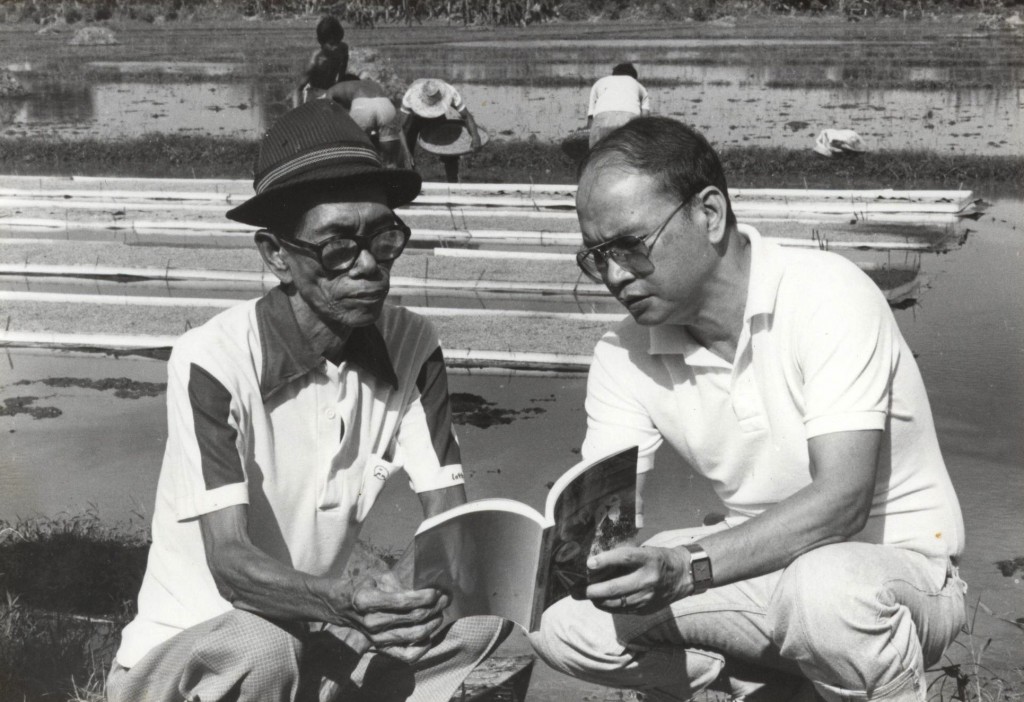
Dr. Benito Vergara’s ministry on spreading proper rice farming techniques to the farmers led him to showing the descriptive and very informative illustrations in his book. (Photo: philscitech.org)
Museums of pedestals and pages
In his last years at IRRI, Dr. Vergara pursued his dream of a rice museum: a venue dedicated to preserving and promoting the science and culture of rice and the rice-growing world. Dr. Vergara conceived of and built the Riceworld Museum and Learning Center to educate the public about different varieties, how rice is produced, and how cultures around the world are shaped by rice consumption and agriculture. It remains one of the top destinations for student science field trips, featuring ancient rice farming tools, short films, and rice grains and hulls dating back to 2,500 BC. It also includes exhibits on women in rice, farmer’s clothing, and rice biotechnology. Since that first foray into museums, Dr. Vergara, as a board member of the National Museum of the Philippines, has contributed to the development and curation of numerous other museums, including the Philippine Science Heritage Center at DOST.
Dr. Vergara continues his project of illustrating, cataloging, and photographing plants. He slowly segued from rice to ornamental plant varieties, publishing a collection of catalogues over the years that are valued for their completeness. At any given point, he is working on a catalogue, collecting and organizing photos of ornamentals that he sees in markets during travels, and ones that he breeds in his garden. He insists on taking the photos rather than hiring a professional photographer because, he says, “I know which features of the plant need to be shown, which features are unique. And if I don’t like the photograph, I could easily take it again.”
In addition to plant catalogues, Dr. Vergara has branched out into children’s literature, leading a book project called Gabby Ghas, about a seed of rice that grows into a plant and becomes rice. The story follows the growth process of a rice plant, with a main character whose life goal is to feed a hungry child. It has been endorsed by the Department of Education and is a regular feature of classrooms across the country.
Retirement: Promoting science and serving the community
It has been almost 20 years since Dr. Vergara retired from IRRI, and a career’s worth of work has been accomplished and continues in his later years. These days Dr. Vergara is more often referred to as Lolo Ben. He and his wife Lina have three children and four grandchildren. In a talk he delivered to fellow scientists recently, he reported that he worked more during his retirement than he ever did while employed full-time at IRRI.
If you were to look for him in the early morning hours, you would have to search in his sprawling garden and watch for a fisherman’s bucket hat that would bob around as he walked among the rows of plants. As both a businessman selling plants and a botanist, he works to make his garden both a showcase of his products and a laboratory for developing new varieties. At any point, he would have an obsession for a single plant: a fruit tree, a fern, a flower — it depends on what he finds. These plant varieties are as diverse as they come: Plumeria, Capsicum, Syzygium samarangense (macopa), citrofortunella, anthuriums, orchids, Cordyline fruticosa (ti plants), heliconias, and Bougainvilleas. He would collect different varieties, photograph and catalogue them, and then write a full-color book describing each plant, listing scientific information, propagation requirements, and common and commercial names.
Recently, Dr. Vergara has embarked on selecting and breeding fruit trees of economic value. In collaboration with the Mama Sita Foundation, he has identified, bred, propagated, and promoted the Mama Sita Banana, the Luz calamansi, and the Mama Sita Macopa—all at his Los Baños farm. The Luz calamansi is a larger, juicier version of the Philippine lime that has 3-4 seeds instead of the usual 10-12, all while retaining the same flavor as its smaller counterpart. The Mama Sita banana’s flavor is somewhere between the eating banana’s and the cooking banana’s; it is starchier and sweeter than the lakatan variety usually seen in the market. Possibly the best feature of this banana variety is its stout and low tree profile, making it very resistant to typhoons.
And Dr. Vergara didn’t stop there. While working on the banana, he organized a backyard production facility for banana chips that were sold in stores and restaurants, proving its economic viability. While his project on Luz calamansi was ongoing, he had worked with a small food company specializing in artisanal preserves to create a calamansi jam. If you visit his house, his wife Lina would have a selection of offerings of new food products coming from one or the other of Dr. Vergara’s projects.
Outside of his work in science, he serves tirelessly in the community. He is a long-serving church elder at Church Among the Palms, working to expand the church, help administer its school, start scholarships, and organize its community engagements. Dr. Vergara is his church’s go-to landscape artist and flower and plant arrangement expert, constantly on-call for all the church events. As president of the Los Baños Orchid Society numerous times, he helped make the bi-annual garden shows central to the ornamental plant industry of the region. In 2004 he was awarded Outstanding Citizen of Los Baños by the town’s mayor recognizing both his scientific achievements and contributions to the community.
And all this—a life in research, and communicating the importance of science to a worldwide public—accomplished without even a single desk in his house. Perhaps this is because his work, and the source of his passion, was always outside: in the fields, in the gardens, in the wild, underneath the sun. A man at home among the plants and leaves and flowers that he loves.
Dr. David is a professor at the College of Mass Communication, University of the Philippines Diliman.
This article is reposted with permission from the International Journal of Philippine Science and Technology.

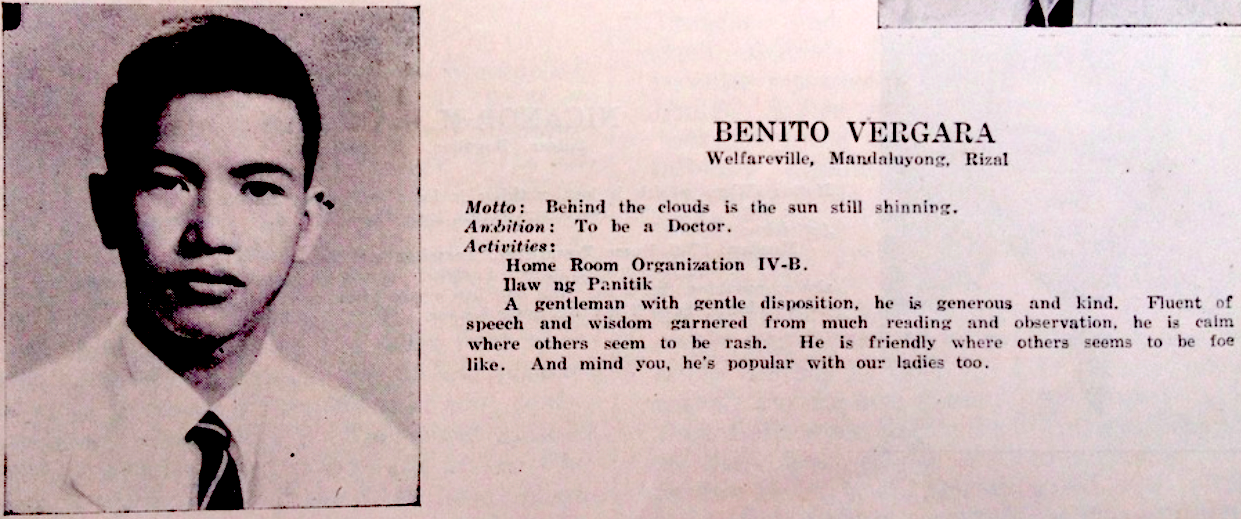
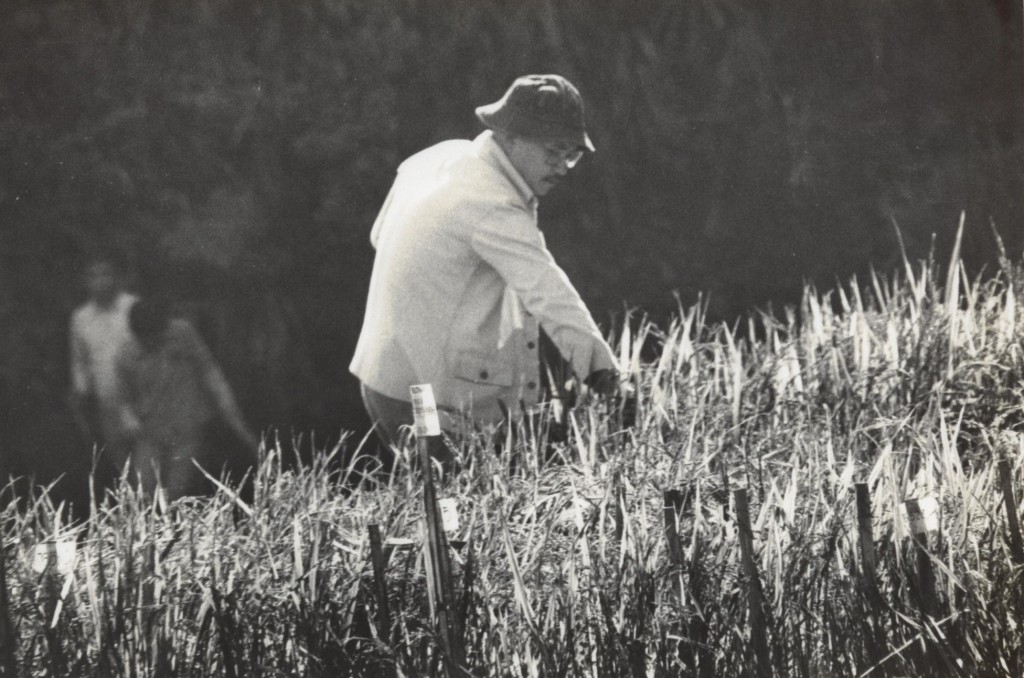
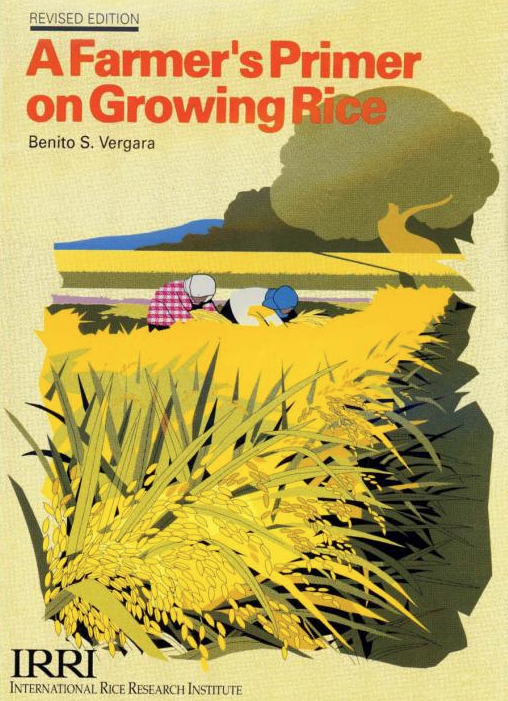
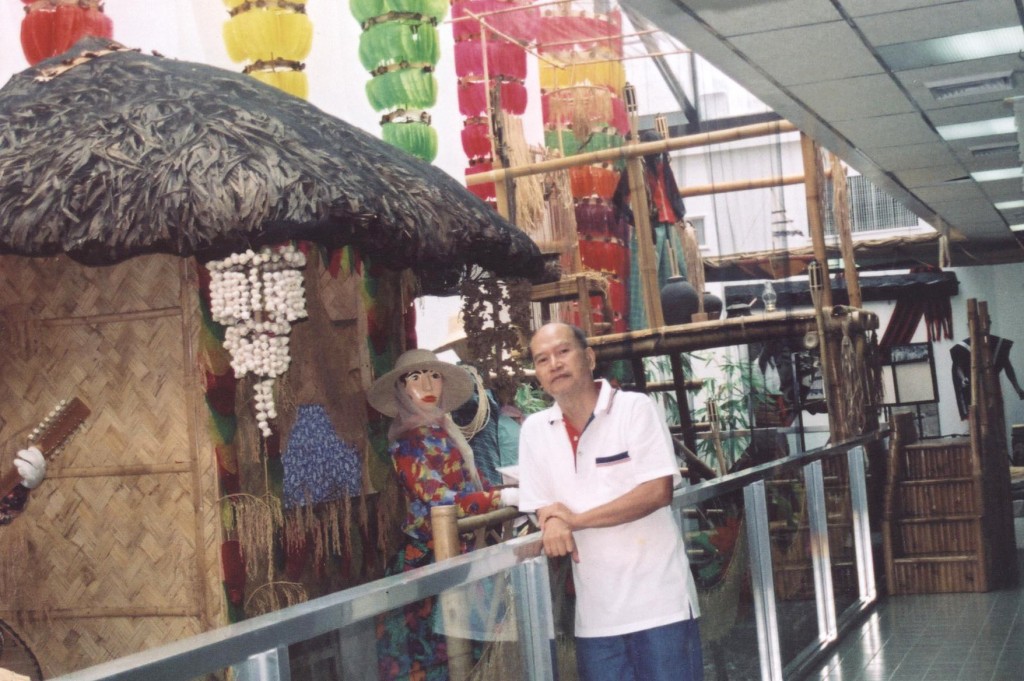







my grandpa! =)